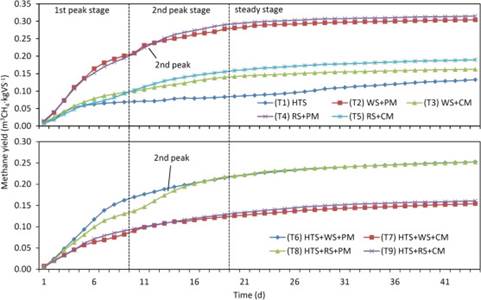烟草秸秆资源化利用获进展
来源:《生物资源技术》
作者:王树声等
时间:2015-07-08

烟草秸秆木质化程度高,非常难腐解,其资源化利用一直是个难题。近日,记者从中国农业科学院烟草研究所获悉,该所联合环发所和沼科所共同攻关,探索解决烟草秸秆资源化综合利用难题,并取得突破性进展。
在炭化利用方面,项目组将烟草秸秆制成生物质炭粉开发烟草育苗基质取得成功。在烟草漂浮育苗中,利用生物炭替代泥炭,达到了减少泥炭用量,进而保护环境的目的。在烟草托盘育苗中,利用生物炭替代腐熟秸秆或圈肥,避免了潜在的病害威胁,提高了育苗基质的质量。该项研究成果已申请发明专利一项。
在沼气化利用方面,项目组将烤烟秸秆与其它农业废弃物混合作为沼气发酵原料。试验显示,烤烟秸秆的甲烷产率与水稻秸秆类似,比玉米秸秆和小麦秸秆略低,有较好的产气潜力。厌氧过程对烟草黄瓜花叶病毒(CMV)、烟草普通花叶病毒(TMV)有抑制作用,由此认为沼气发酵液用作农田,特别是茄科作物农田的有机肥料循环利用是可行的。
相关论文于近期发表在《生物资源技术》(Bioresource technology)上。(来源:中国科学报 迟立鹏 李晨)
Co-digestion of tobacco waste with different agricultural biomass feedstocks and the inhibition of tobacco viruses by anaerobic digestion
Abstract Tobacco is widely planted across the world especially in China, which means that a large amount of tobacco waste needs to be treated. This study investigated the biogas fermentation of tobacco stalks co-digested with different biomass feedstocks and the inactivation of Tobacco mosaic virus (TMV), Cucumber mosaic virus (CMV) by anaerobic digestion. Results showed that the maximum methane yield of tobacco stalks at 35 °C was 0.163 m3 CH4⋅kg VS−1, which was from the co-digestion of tobacco stalks, wheat stalks and pig manure. The largest VS removal rate of tobacco stalks was 59.10%. Proven by indicator paper stripe, half-leaf lesion and RT-PCR, CMV could be inactivated by mesophilic and thermophilic anaerobic digestion, whereas TMV could be only inactivated by thermophilic anaerobic digestion over 20 days. These results suggested that using tobacco stalks as feedstock for anaerobic digestion and applying the digested residue and slurry to Solanaceae crop land are feasible.
原文链接:http://ac.els-cdn.com/S0960852415004861/1-s2.0-S0960852415004861-main.pdf?_tid=ce7d24de-2149-11e5-bc34-00000aab0f27&acdnat=1435903838_371a24c7dbb31b7d640a499c1c9e9a8d




